Violet oil, an infused oil from the wild violet plant’s leaves and flowers, is easily made. Violet oil has many uses and benefits, some of which may just surprise you!
This post may contain affiliate links at no additional cost to you. By making your purchases through the links on this website, IMSL may make a small percentage at no direct cost to you. IMSL only promotes products we use & truly believe in. Please refer to my Privacy & Disclosures for further information. IMSL thanks you for your support!
It makes me giddy when Mother Nature offers a plant that’s not only beautiful, delicious and edible, but also one that I can use in so many applications for its healing properties. And the violet plant does not disappoint.
Making violet oil is one of my favorites to make and have available to use throughout the year!
VIOLET OIL
You may be asking, exactly what is violet oil, aka, wild violet oil? The oil I’m describing and sharing how to make on your own is an infused oil, NOT an essential oil.
Sharing Is Caring ❤️
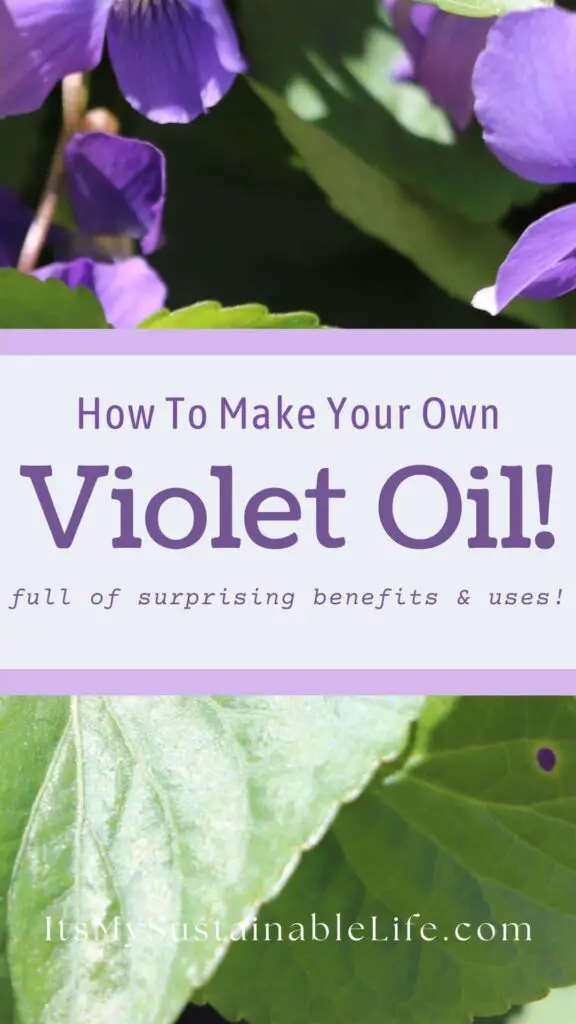
DIFFERENCES BETWEEN ESSENTIAL OILS AND INFUSED OILS
Although both are aromatic oils which are created using plant material, it’s the process of how those oils are created that makes the difference.
Essential oils, also known as the “essence” of a plant, are made using a distilling process using massive amounts of plant material to create a concentrated oil.
Unfortunately, this process captures about ⅓ of the plant’s properties! Seems a bit of a waste to me 😳
Essential oils are, however, extremely concentrated. Sadly, this makes this type of oil unavailable to use for many due to individual sensitivities.
Violet essential oil term is interchangeable with “violet leaf absolute”, both of which are extracted from the leaves of the Viola odorata plant.
Infused oils on the other hand, are oils that have been just that. Infused into a carrier oil with the plant material over a period of time.
Infused oils absorb the plant’s healing properties and components fully, and include traces of its essential oils as well.
Often those with sensitivities to the essential oil are able to utilize the infused oil with no issue. Obviously, any allergies to the plant itself should be a warning that that particular infused oil is not one you may want to give a go!
VIOLET OIL DEFINED
Violet oil is an oil that is infused with the leaves and flowers of the violet plant over an extended period of time.
As this plant is mainly available here in the Northeast during the springtime, but can often be harvested throughout the growing year as it’s the leaf we are mainly after, is one oil that I am sure to make and have on hand while available.
When you are looking to capture the benefits of the violet plant, especially for making homemade skin care products like lotions, salves and balms, and deeply moisturizing body butter, making this infused violet oil is key to harnessing the healing and soothing properties of the violet plant!
VIOLET OIL BENEFITS & USES
The violet plant, a common spring blooming plant, is native to North America from the Rocky Mountains eastward. It’s often referred to as “common”. I, however, find it amazing in both its benefits and uses when made into an oil.

So what are the benefits and uses of violet oil that has been infused? Here you go, just a few of my favs …
DISCLAIMER
Recommendations and or suggestions made by this blog regarding husbandry and or herbal remedies etc. are not meant to replace solid advice from qualified professionals. None of the information on this blog has been evaluated by the FDA. Products or remedies mentioned are not intended to diagnose, treat, cure or prevent disease. Please do your due diligence. Research, talk to qualified professionals and proceed at your own risk.
IMPROVED SKIN
The mucilage within violet oil aids those dealing with inflamed skin issues. When used in the making of this highly moisturizing whipped body butter, you can be sure it will do double time in aiding dry skin.
Its anti-inflammatory properties may soothe acne or eczema flares, and the salicylic acid helps clear skin abrasions.
Its antiseptic and antimicrobial properties aid wounds by cleansing and removing lingering bacteria, and even may help those with varicose veins.
Violet oil is gentle and an amazing alternative from conventional skin care products which are filled with many unknowns.
Utilize this amazing oil on any area’s of the skin that need some love by simply massaging into the area well.
ENCOURAGES LYMPH FLOW
Our lymphatic system, is basically the system in our bodies that produces, stores, and carries white blood cells that fight infections and other diseases. This complex system includes our bone marrow, spleen, thymus, lymph nodes, and lymphatic vessels.
The lymph systems functions boil down to 3 major responsibilities in the body.
- Tissue drainage
- Fat transport
- Immune responses
When the lymphatic system becomes overloaded, our glands become swollen or hard, both of which can physically felt. This stress can lead to issues such as sinusitis, ear issues, and breast tenderness.
Violet oil has an affinity for the lymphatic system and it helps improve circulation & movement of it, especially when massaged into the skin and affected areas of the body. The lymphatic system is now being studied as a “potential therapeutic agent in breast cancer” treatments.
Utilize violet oil as a massage directly onto lymph areas that may need encouragement in moving.
AIDS SLEEP ISSUES
Ahhh, the elusive sleep. Good sleep is essential for proper body and brain function. Fortunately for those dealing with insomnia and sleep issues, violet oil to the rescue!
Traditional Iranian Medicine has utilized violet oil taken via nasal drops extensively as a natural aid for sleep disorders. And now it’s not just considered a “wife’s tale” as an effective treatment as this study shows.
Utilize violet for its aromatic properties to induce sleep by adding it to a diffuser or vaporizer.
Alternatively, massage this oil into marma points on the body known to aid sleep. I like to massage onto the inner wrists, palms, bottom of feet, and lips prior to bed.
PAIN MANAGEMENT
Salicylic acid and violet’s anti-inflammatory properties once again displays its powers in relieving pain, headaches, muscular and joint pain like arthritis, gout, and rheumatism.
Utilizing violet oil not only aids in reducing overall pain in these areas, but encourages blood circulation to them as well. All helping to alleviate and speed relief.
Tired, achy muscles and joints? Enjoy the oil as a therapeutic bath and soak them away. Need a bit more direct relief? Use the oil as a massaging rub directly where needed, or add a bit to a warm compress and press on the affected area.
Bug bites or bee sting? Use violet oil (several drops) along with 1 Tbl white vinegar soaked into a cotton ball and place on the bite until the pain subsides.
STRESS RELIEF
Stress, a body’s reaction to demanding situations, can lead to migraines, headaches, muscle tension, exhaustion (both physically and mentally), fatigue, anxiety, and even dizziness.
Violet oils’ calming properties support and encourage a state of tranquility and peace both in body and mind, by simply rubbing a bit on area’s of the body that are in need of relief.
PET ANXIETY & STRESS RELIEF
Have anxious or nervous dog? Utilize violet oil to help calm and relax him/her.
Applying topically, ingested (only when an edible carrier oil is used), or inhaled, the soothing elements of violet oil can help invoke a sense of comfort and safety.
RESPIRATORY RELIEF
A simple massage of violet oil into the breast and lung area of the body can work as a decongestant and expectorant. Thus, relief from any issues surrounding the lungs and respiratory systems can be enjoyed.
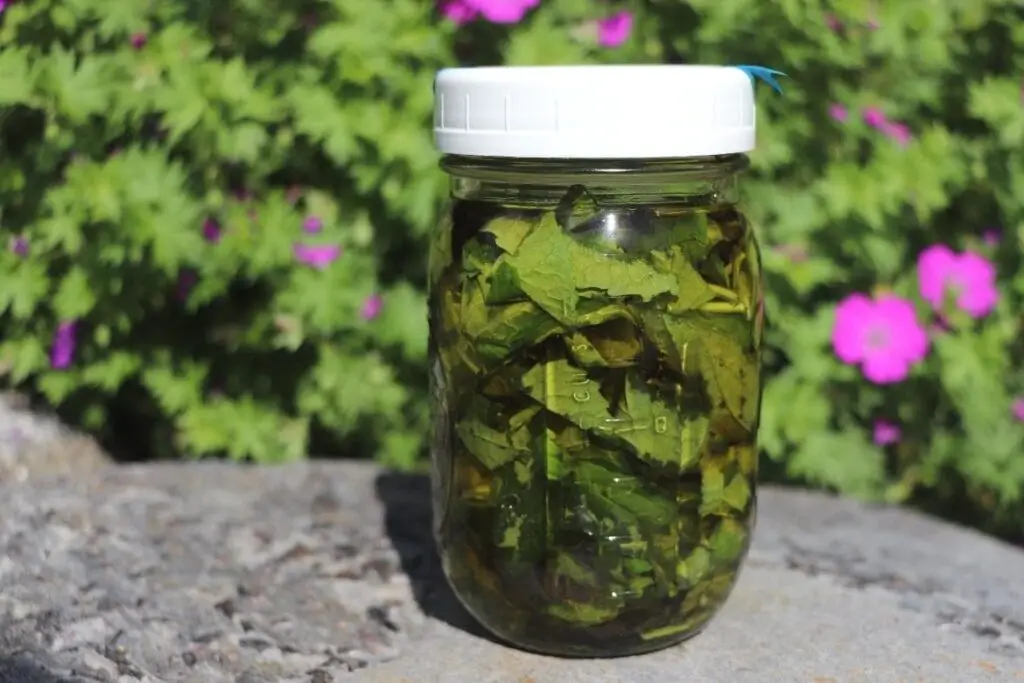
Enjoy a few drops of violet oil in your favorite diffuser, steam bath, or creating a tent with a pan of boiling water and a towel, deeply inhaling its beautiful scent.
ADDITIONAL VIOLET OIL USES
TOPICAL HEALING USES
Violet Massage Oil
Use as a massage oil for overall skin health, achy muscles and joints, breast health, varicose veins, and even as a scalp massage to promote healthy scalp and hair.
Base For Salves, Balms, & Lotions
Substitute violet infused oil as a base oil when creating homemade salves and balms and even sunscreen! You can be sure to utilize these products when helping skin issues, bug bites, and sunburn!
Added to dandelion salve this salve will do double duty when aiding sore muscles and joints!
When adding violet oil to my Healing Gardener’s Hand And Skin Salve you can bet your bottom dollar my dry, cracked hands will be getting the nourishment they need to heal quickly.
Poultices & Compresses
Utilize violet oil in your next poultice or compress to help relieve chafed skin, abrasions, bites, or any inflamed area of the skin.
COSMETIC USES
Lip Balm
As a beekeeper we enjoy all the benefits those little workers offer, honey included.
When violet oil is added to my honey lip balm, my lips have never felt so nourished and healthy.
NOTE: Recipe coming soon!
Scrubs & Rubs
Add this infused oil when making salt or sugar scrubs & rubs and be on the receiving end of the violet’s healing properties!
Moisturizers & Lotions
A great base oil for any homemade lotion or moisturizer recipe as a skin soothing lubricant!
KITCHEN DISHES
Violet oil, when made using an edible carrier oil such as EVOO, Grapeseed, Safflower and so many others, makes for a great addition to many culinary dishes.
Dressings & Marinades
Use this edible, healthy infused oil as the oil base for your favorite homemade dressing and marinades.
As An Oil Substitute
Use an edible version of violet oil as a substitution for any dish that calls for your oil of choice.
VIOLET OIL CONTRAINDICATIONS
Violet oil taken internally is NOT recommended for those who’ve inherited G6PD deficiency.
Using violet whenG6PD deficiency is present, lack of the enzyme G6PD (glucose-6-phosphate dehydrogenase) can aggravate hemolytic anemia.
HOW TO MAKE VIOLET OIL
Obviously to make this efficacious oil you will need violets. Wild violets that is.
Foraging these delicate flowers and leaves each spring & summer is a joy. Foraging Wild Violet will give you all the information you need in identifying and gathering this plant. Or watch the video below.
When foraging, knowing where your plant is growing & what it is exposed to is key to making sure that it is free from harmful sprays, chemicals, and even animal waste. Gather the plant material once the dew has dried, preferably in the mid to late morning hours.
Although both the flowers and leaves can be utilized in the making of violet oil, I recommend the majority of plant material is made up of the leaf.
The violet leaf, as stated in Foraging Wild Violets is where the majority of its healing properties reside.
“When looking to utilize this plant for its medicinal properties, use the leaves.”
IMSL
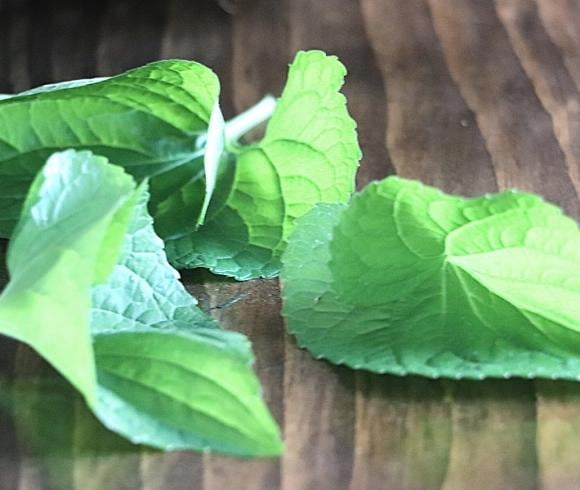
It’s recommended when foraging and harvesting violet leaf that you take it from the top 25% of the plant and select the leaves with a bit of curling present.
SOURCING VIOLET PLANT MATERIAL
Should you not have violet available in your area, Mountain Rose Herbs would be where I would source some dried leaf.
Once you’ve gathered your violet and leaf plant material, time to choose whether to wash or not wash.
PREPARE VIOLET PLANT MATERIAL FOR MAKING VIOLET OIL
To wash or not wash. That is the question that many herbalists differ. Some prefer washing the fresh plant material as a rule of thumb, others not so much.
Considerations of whether to wash or not …
- SOURCING – Consider where you have sourced your violet plant material as described above
- MARKETING – Will you be marketing or selling products which you’ve made using your violet oil? A consideration worth thinking about
- GIFTED | PURCHASED – Did you receive your plant material from a friend and are unsure about where it was gathered? Or possibly purchased some and unsure about how it reached your counter
HOW TO WASH VIOLET PLANT MATERIAL
If you are unsure about any or all of the above or your plant material is pretty dirty, washing is strongly suggested.
To wash violet plant material, simply spray gently to rinse completely. Alternatively, the material can be completely submerged in a cold water bath and agitated to release any dirt or debris.
When concerned with chemical use or animal contamination, add a natural fruit and veggie wash to the mix, soaking for a few minutes.
Rinse the material well. Placing the rinsed material into a salad spinner & spin well helps to remove most of the moisture from the delicate flowers and leaves.
Lay the material out on a dry towel and gently pat dry. Leave the material to air dry completely for 24 to 48 hours to ensure that there is no remaining moisture left or you risk molding.
For me, I’m fortunate to be able to gather and use plant material free from all of the above, so I can skip the wash all together.
CHOOSING A CARRIER OIL
Choosing an appropriate carrier oil is largely dependent on what you will be using the violet oil for.
For instance, if you are looking to aid issues with acne, you would want to choose an oil that is low on the “comedogenic scale”.
The comedogenic scale is simply a rating of 0 to 5 used as a measuring the likelihood of that product clogging the pores of the skin. The lower the rating, the less likely it will clog pores.
Here is a breakdown of my top 3 carrier oil choices for making violet oil in no specific order. As always, I recommend using only organic options when possible.
- EVOO – High in vitamins, antioxidants (hydroxytyrosol) this oil has a comedogenic rating of only 2. Great for aging, dry skin, but may be heavy for those prone to breakouts
- SWEET ALMOND OIL – With a comedogenic rating of 2, this oil makes a good choice for those whose skin is dry yet sensitive. This oil is said to help collagen production, relieves rashes & burns, and protects against UV damage. Those with allergies to nuts to stay clear of this oil
- ARGAN OIL – A rating of 0 makes this oil a great choice for many looking to improve skin elasticity, heal skin infections, prevent sun damage, and offer anti-aging effects.
Still need more carrier oil choices? Take a look at this Lavender Oil tutorial which goes into 12 different options!
I’ve used organic EVOO in the making of this violet oil, which I can use in all its glory for my culinary, healing topical uses, as well as cosmetic uses.
GATHER THE EQUIPMENT
To make your violet oil infusion, gather the following equipment and ingredients …
- Mason jar or recycled jar of choice with cover
- Preferred oil
- Violet plant material
MAKE VIOLET OIL
You have two options of how you want to create your violet infused oil. The slow method or the fast method.
SLOW METHOD VIOLET OIL
STEP 1
Prepare the plant material by rolling it into bundles and giving it a coarse chop on a cutting board.
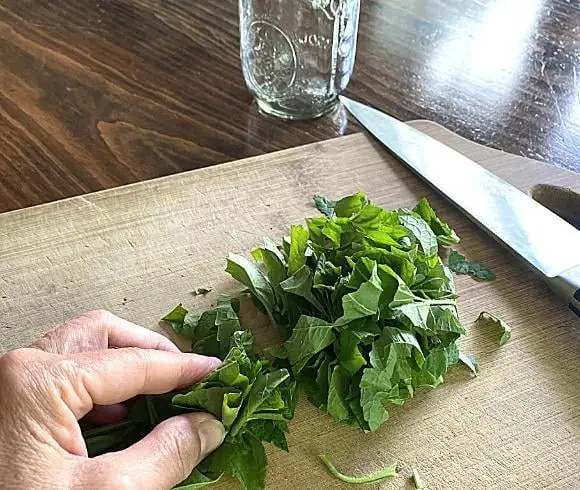
This exposes more of the healing properties (like its natural essential oils) to the oil of your choice.
STEP 2
Fill your jar with the prepared plant material, filling to ¾ way full of violet leaf (adding a few flowers if you like). At a minimum, to ½ way filled.
STEP 3
Pour your carrier oil of choice over the plant material. The plant material should be completely covered or submerged in the oil by at least 1 to 2 inches.
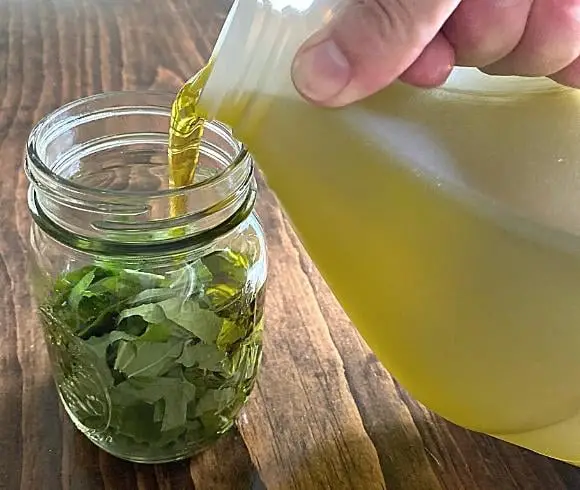
STEP 4
Cover or cap your filled jar. If you are using unwashed plant material, capping the jar with a closable lid is fine. I prefer using these reusable mason jar covers for ease.
When using plant material which has been washed, you may want to cover using cheesecloth, flour sack towel, or muslin secured with a rubber band which allows the mix to breath and release any moisture which may still be present.
STEP 5
Place the filled and covered jar in a dark, cool cupboard for 4 to 6 weeks to infuse completely.
Alternatively, some (like the famed herbalist Rosemary Gladstar & me 😊) enjoy harnessing a bit of the sun’s energy when infusing oils by leaving the jar in a bright, direct sun spot to gently warm as it’s infusing.
Give the jar a gentle shake or stir every now and again to allow complete coverage and exposure of the oil to the plant material.
FAST METHOD VIOLET OIL
Don’t have 4 to 6 weeks to wait for the violet oil to infuse? Consider what I like to call the “fast method” oil infusion using the slow cooker.
To make violet oil using the fast method, follow steps 1 through 4 above in the slow method.
From there …
STEP 5
Line the bottom of your slow cooker with a folded tea towel or dish rag and place your filled and capped (either a cover or a breathable cloth) jar on top of the towel.
STEP 6
Fill the crock pot or slow cooker with water until it reaches mid-way to ¾ way up the jars side.
STEP 7
Leave the lid of the crock pot or slow cooker OFF, leaving the jar and water open to the air.
STEP 8
Turn the pot to its lowest setting available, bringing the oil and its contents to a warm temperature of about 100°F. Leave the jar to heat continually for at least 24 hours if not 48 hours.
STRAIN THE OIL
No matter which method of infusion you decide to use, once the infusion times are complete it’s time to strain the plant material from the oil.
Using a fine mesh strainer, a flour sack towel, muslin bag, or cheesecloth, strain the oil into another jar to separate the leaves and plant material from the oil.
Make sure to completely squeeze every ounce of oil you can from the plant material wasting none!
Lastly, label your oil jar with the name and date of the contents & enjoy!
Now that you’ve learned how to make violet oil and all its benefits and uses, I hope you put this magical oil to good use!
What will you be making with your violet oil?
Love, Light, & Laughter ~

SHOP THIS POST
Enjoy this article? Please consider sharing it on your favorite social media channel! Want more? Subscribe below for the occasional update with all the “happenings on the hill”!

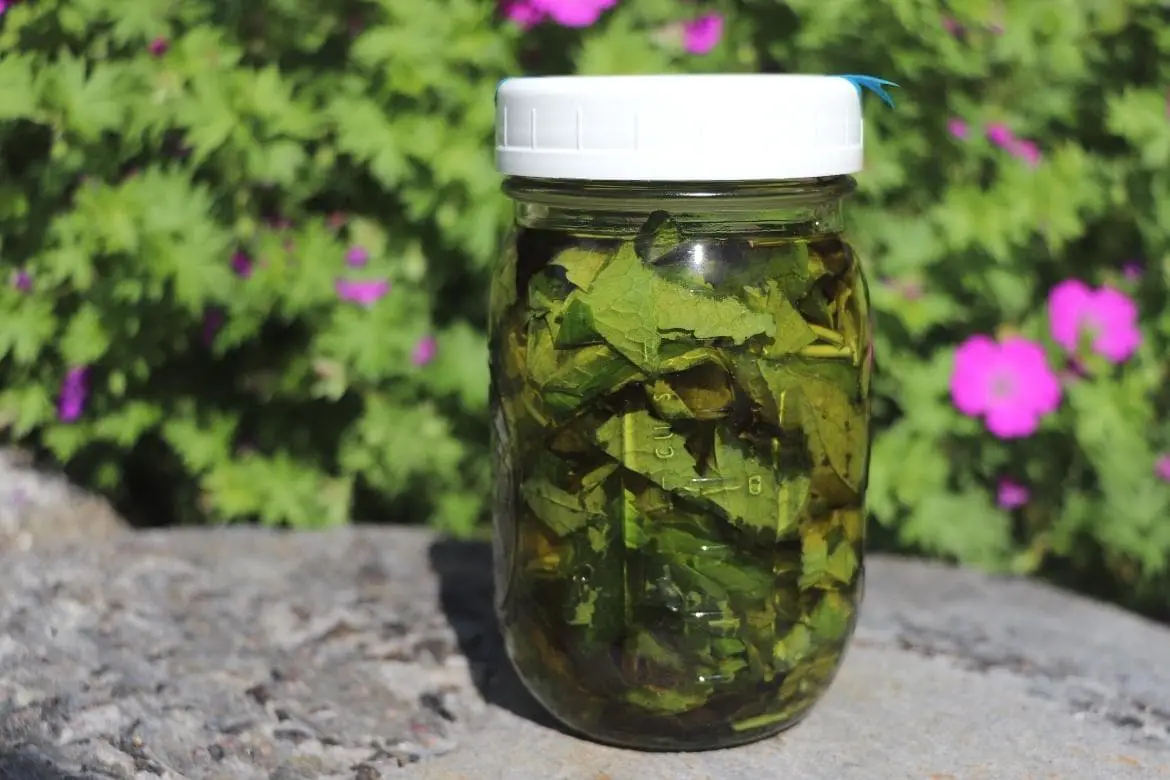

11 comments
We have not heard of violet oil, thank you for sharing. The uses are many and beneficial.
This is such a cool and helpful resource guide! Love learning how to make violet oil and about all the healthy benefits!
I never knew you could make violet oil! I will be saving this and giving it a try next spring. Thank you!
I like learning about the benefits of Violet oil. The scent is pleasant to me. I like having it in my home.
Wild Violet grows in my backyard garden. It’s past the blooming season now but I want to make the violet oil next spring! I do make violet tea from the flowers and leaves.
Hopefully you still have violet foliage still available! If so, this is where the majority of health benefits come from 😊. If not, there is always next spring!
I’d never heard of violet oil before. I love trying different moisturizers, so I may need to try this. Also, the sleep aid properties sound nice. It would be great to use on the skin right before bed.
It absolutely is! Hope you can give it a try!
This is such an informative post on violet oil! Thank you! I’ve never known the difference between essential oils and infused oils.
So, this has been the year of the violets for me! Ironically, I have transplanted several all around this spring!
Wow, there are so many great uses for violet oil! Love a natural remedy.